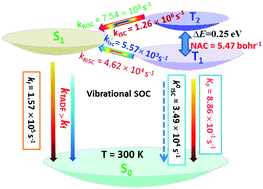A new mechanistic study of a second generation TADF material based on the path integral approach incorporating Herzberg–Teller and Duschinsky rotation effects†
Abstract
The quantitative predictions of the photophysical processes for a next generation thermally activated delayed fluorescence (TADF) molecule are calculated by employing the path integral approach to dynamics considering the Herzberg–Teller (HT) and the Duschinsky rotation effects within a multimode harmonic oscillator model. Our theoretical results indicate that thermal activation is no longer a delayed fluorescence issue at T = 300 K for an almost “zero-energy gap” complex with ΔE(1CT−3CT) ≈ 10 cm−1 between the excited singlet 1CT(S1) and triplet 3CT(T1) states. The direct spin–orbit coupling between the 1CT and 3CT states is strictly forbidden, and vibronic coupling (i.e., HT effect) is expected to play a critical role in the fluorescence emission, efficient intersystem crossing (ISC) and reverse ISC (RISC) processes. Results show that the fluorescence emission of the molecule possesses enough stability due to the natural vibration modes of the molecule; however, the RISC and ISC rates are still slower, corresponding to values of 4.62 × 104 and 5.57 × 103 s−1 considering the HT case, respectively. We also found that some energy excited states similar to 1,3CT can easily mix their character with the 1CT and 3CT states via multiple coupling routes of zero-field splitting (ZFS) interaction (calculated ZFS parameters, E/D ≈ 1/3), and configuration interaction (nonadiabatic coupling of 5.47 bohr−1 between T1 and T2 states), which will greatly accelerate the ISC and RISC processes. The calculated ISC rate of S1 → T2 of 1.26 × 105 s−1 is found to be much faster than that of S1 → T1 (5.57 × 103 s−1), and the RISC rate of 7.54 × 108 s−1 of T2 → S1 is ∼1000 times faster than the S1 → T2 process, which leads to the fact that an emitter, compound 1, can directly harvest all singlet and triplet excitons with the help of the proximate energy excited states without the delayed fluorescence processes. These results are in excellent agreement with the experimental observation of the direct singlet harvesting mechanism, and also will provide a new design concept for the development of TADF molecules.



 Please wait while we load your content...
Please wait while we load your content...